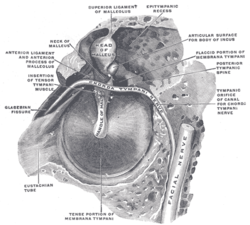The malleus, or hammer, is a hammer-shaped small bone or ossicle of the middle ear. It connects with the incus, and is attached to the inner surface of the eardrum. The word is Latin for 'hammer' or 'mallet'. It transmits the sound vibrations from the eardrum to the incus (anvil).
| Malleus | |
|---|---|
 Left malleus. A. From behind. B. From within. | |
 The right eardrum with the hammer and the chorda tympani, viewed from within, from behind, and from above (malleus visible at center) | |
| Details | |
| Pronunciation | /ˈmæliəs/ |
| Precursor | First branchial arch |
| Part of | Middle ear |
| System | Auditory system |
| Identifiers | |
| Latin | malleus |
| MeSH | D008307 |
| TA98 | A15.3.02.043 |
| TA2 | 881 |
| FMA | 52753 |
| Anatomical terms of bone | |
Structure
editThe malleus is a bone situated in the middle ear. It is the first of the three ossicles, and attached to the eardrum (tympanic membrane). The head of the malleus is the large protruding section, which attaches to the incus. The head connects to the neck of malleus. The bone continues as the handle (or manubrium) of malleus, which connects to the tympanic membrane.[1] Between the neck and handle of the malleus, lateral and anterior processes emerge from the bone.[2][3] The bone is oriented so that the head is superior and the handle is inferior.[3]
Development
editEmbryologically, the malleus is derived from the first pharyngeal arch along with the incus.[3] In humans it grows from Meckel's cartilage.[3]
Function
editThe malleus is one of three ossicles in the middle ear which transmit sound from the tympanic membrane (ear drum) to the inner ear. The malleus receives vibrations from the tympanic membrane and transmits this to the incus.[2]
Clinical significance
editThe malleus may be palpated by surgeons during ear surgery.[1] It may become fixed in place due to surgical complications, causing hearing loss.[1] This may be corrected with further surgery.[1]
History
editSeveral sources attribute the discovery of the malleus to the anatomist and philosopher Alessandro Achillini.[4][5] The first brief written description of the malleus was by Berengario da Carpi in his Commentaria super anatomia Mundini (1521).[6] Niccolo Massa's Liber introductorius anatomiae[7] described the malleus in slightly more detail and likened both it and the incus to little hammers terming them malleoli.[8]
Other animals
editThe malleus is unique to mammals, and evolved from a lower jaw bone in basal amniotes called the articular, which still forms part of the jaw joint in reptiles and birds.[9][10]
Additional images
edit-
Ossicles
-
Head and neck of a human embryo eighteen weeks old, with Meckel's cartilage and hyoid bone exposed.
-
External and middle ear, opened from the front. Right side.
-
Chain of ossicles and their ligaments, seen from the front in a vertical, transverse section of the tympanum.
-
CT image of malleus
-
Auditory ossicles. Tympanic cavity. Deep dissection.
-
Auditory ossicles. Incus and malleus. Deep dissection.
See also
edit- Bone terminology
- Evolution of mammalian auditory ossicles
- Ligaments of malleus
- Terms for anatomical location
References
edit- ^ a b c d Lippy, William H.; Berenholz, Leonard P. (2010). "25 - Special Problems of Otosclerosis Surgery". Otologic surgery (3rd ed.). Philadelphia: Saunders. pp. 293–303. doi:10.1016/B978-1-4160-4665-3.00025-1. ISBN 978-1-4377-1966-6. OCLC 489078311.
- ^ a b Mitchell, Richard L. Drake, Wayne Vogl, Adam W. M. (2005). Gray's anatomy for students. Philadelphia, Pa.: Elsevier. p. 862. ISBN 978-0-8089-2306-0.
{{cite book}}: CS1 maint: multiple names: authors list (link) - ^ a b c d Cunningham, Craig (2016). "5 - The Skull". Developmental juvenile osteology. Louise Scheuer, Sue M. Black, Helen Liversidge, Angela Christie (2nd ed.). Amsterdam: Academic Press. pp. 43–148. doi:10.1016/B978-0-12-382106-5.00005-0. ISBN 978-0-12-382107-2. OCLC 956277358.
- ^ Alidosi, GNP. I dottori Bolognesi di teologia, filosofia, medicina e d'arti liberali dall'anno 1000 per tutto marzo del 1623, Tebaldini, N., Bologna, 1623. http://gallica.bnf.fr/ark:/12148/bpt6k51029z/f35.image#
- ^ Lind, L. R. Studies in pre-Vesalian anatomy. Biography, translations, documents, American Philosophical Society, Philadelphia, 1975. p.40
- ^ Jacopo Berengario da Carpi,Commentaria super anatomia Mundini, Bologna, 1521. https://archive.org/details/ita-bnc-mag-00001056-001
- ^ Niccolo Massa, Liber introductorius anatomiae, Venice, 1536. p.166. https://www.digitale-sammlungen.de/en/view/bsb10151904?page=1
- ^ O'Malley, C.D. Andreas Vesalius of Brussels, 1514-1564. Berkeley: University of California Press, 1964. p. 120
- ^ Ramachandran, V. S.; Blakeslee, S. (1999). Phantoms in the Brain. Quill. pp. 210. ISBN 9780688172176.
- ^ Luo, Zhe-Xi (2021). "2.14 - Origins and Early Evolution of Mammalian Ears and Hearing Function". The Senses: A Comprehensive Reference. Vol. 2. Bernd Fritzsch (2nd ed.). Cambridge,Massachusetts: Academic Press. pp. 207–252. doi:10.1016/B978-0-12-805408-6.00033-6. ISBN 978-0-12-805409-3. OCLC 1196340700.